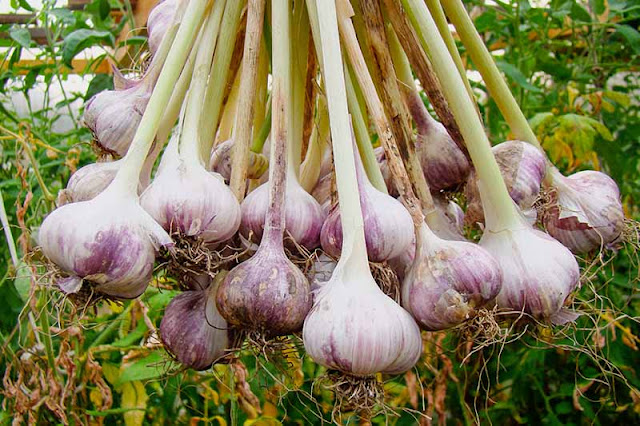How To Grow Garlic - Garlic Growing Tips
Garlic is a wonderful herb grown around the world for everyday culinary practices, seasoning as well as for medicinal purposes.
Garlic is native to Asia mainly in Central Asia and in Iran.
Garlic is a very important part of Asian kitchen. And grows around the world commercially.
HOW TO GROW GARLIC
Propagation of Garlic
Garlic can easily be propagated from a mature garlic cloves. Its very easy to propagate them for kitchen garden, choose a healthy mature garlic which has been harvested and looks disease free.
Planting area preparation
While growing Garlic loves full sun but it can tolerate shades to some extant. Garlic is easy to grow and can be grown year-round in mild climates. Garlic cloves germinate well in semi shade area and Garlic grows best in well-drained, rich, loamy soil mixed with lots of organic matter.
Garlic loves raised beds for plantation if you are not planting them in dry areas.
Planting:
For planting Garlic plant the cloves, the sections of the mature bulb; each planted clove will produce a new bulb again once fully grown and matured.
The healthy and disease free cloves generally yield the biggest bulbs. To keep your garlic cloves free from diseases before planting please soak them in any organic anti fungal solution for at least an hour.
If you do not get organic anti fungal solutions you can do at home by yourself take a tablespoon of baking soda and any seaweed based growth promoter mix both of them with water and soak your garlic for an hour in the solution before planting them.
Plant garlic in the fall.
Spacing
Plant your Garlic 6 to 8 inches apart from each other.
and after placing the cloves in the soil cover them up with at least 2 inch of organically rich loamy soil. In 2 to 4 weeks the Garlic cloves will start sprouting.
Mulching
Garlic loves mulching around them, as they are very poor fighting with weeds, also a healthy organic mulching of composted straws and leaves will keep the soil moist and will save the garlic from frosting.
Watering
Garlic loves regular watering at their early growing stages.Keep your plantation bed moist but now over watered. Excessive watering will initiate root rotting and damages will start to the cloves.
Stop watering when you notice the plant is mature and the leaves are turning yellow to give the clove time to firm up properly before harvesting.
Scape Removal
By the middle of June, Garlic plants will begin sprouting flowery tops that curl as they mature and ultimately straighten out into long spiky tendrils. These flavourful savory stalks are known as Garlic scapes, and it should be removed to promote larger, healthier more efficient bulb growth for harvesting.
Fertilizing
Garlic loves fertilizer in their growth stage, start with foliar feed every two weeks once they start shooting up new leaves. Feed your garlic with seaweed based fertilizer by may , this is the time the bulb under the soil start growing up.
Harvesting
When half to three-quarters of the leaves turn yellow-brown, typically in late June or early July (depending on the variety and the weather), it's harvest time. Carefully dig up each bulb; do not pull, or you may break the stalk from the bulb, which can cause it to rot. Once it's harvested, get it out of the sun as soon as possible.
Tie the garlic together in bundles of 6 to 10 bulbs (label them if you've grown more than one variety) and hang them to cure for about four to six weeks in a shaded, dry, and preferably drafty area.
When your garlic is thoroughly dry, trim the roots, taking care not to knock off the outer skin. Cut off the stalks about 1½ inches above the bulb if you plan to keep the garlic in bags. Recycled mesh onion bags are perfect for storage.
* Disclaimer -
This is a personal blog. Any views or opinions represented in this blog are personal and belong solely to the blog owner and do not represent those of people, institutions or organizations that the owner may or may not be associated with in professional or personal capacity, unless explicitly stated.Any views or opinions are not intended to malign any religion, ethnic group, club, organization, company, or individual.All content provided on this blog is for informational purposes only. The owner of this blog makes no representations as to the accuracy or completeness of any information on this site or found by following any link on this site.The owner will not be liable for any errors or omissions in this information nor for the availability of this information. The owner will not be liable for any losses, injuries, or damages from the display or use of this information.
Downloadable Files and Images-
Any downloadable file, including but not limited to pdfs, docs, jpegs, pngs, is provided at the user’s own risk. The owner will not be liable for any losses, injuries, or damages resulting from a corrupted or damaged file.Images and Logos used in this blog are copyrighted by their respective owners, Images used here are only for representation purposes.
Comments-
Comments are welcome. However, the blog owner reserves the right to edit or delete any comments submitted to this blog without notice due to :
- Comments deemed to be spam or questionable spam.
- Comments including profanity.
- Comments containing language or concepts that could be deemed offensive.
- Comments containing hate speech, credible threats, or direct attacks on an individual or group.
The blog owner is not responsible for the content in comments.This blog disclaimer is subject to change at anytime.





















Post a Comment